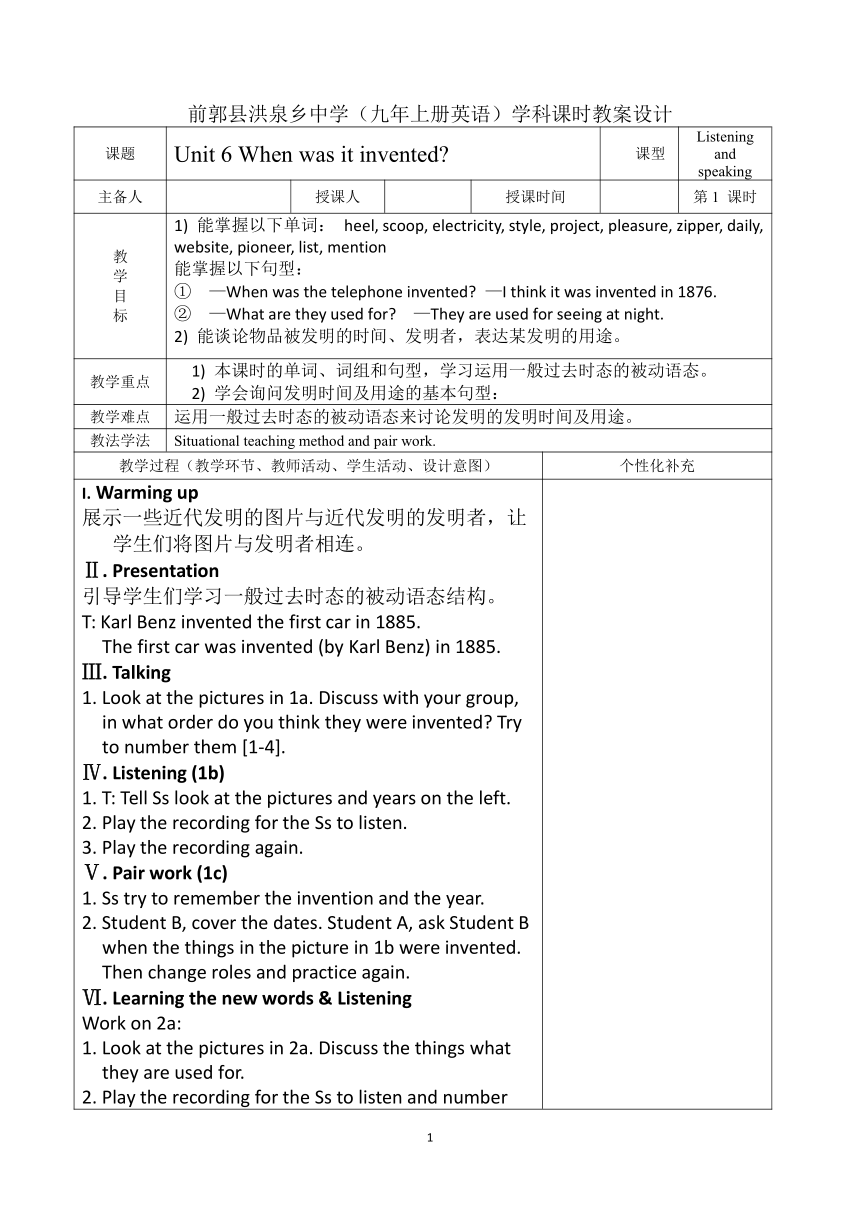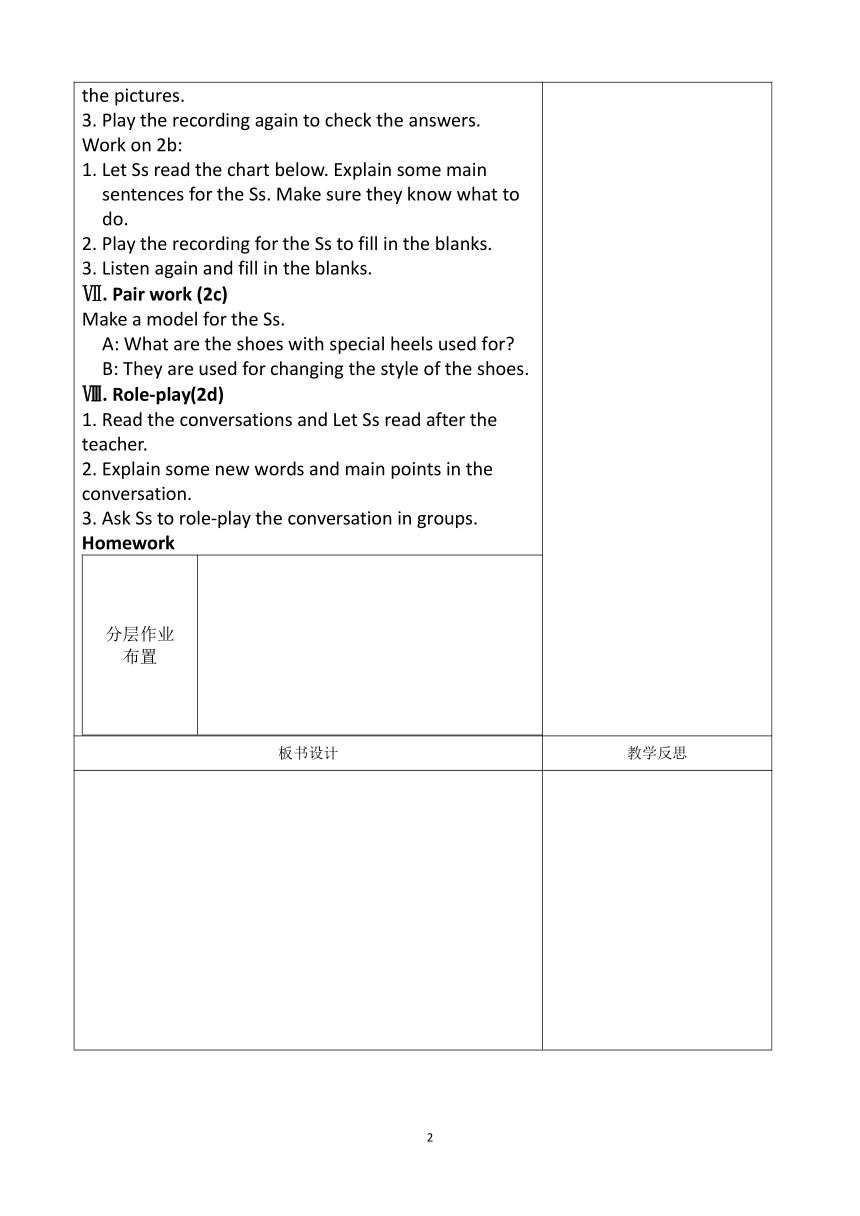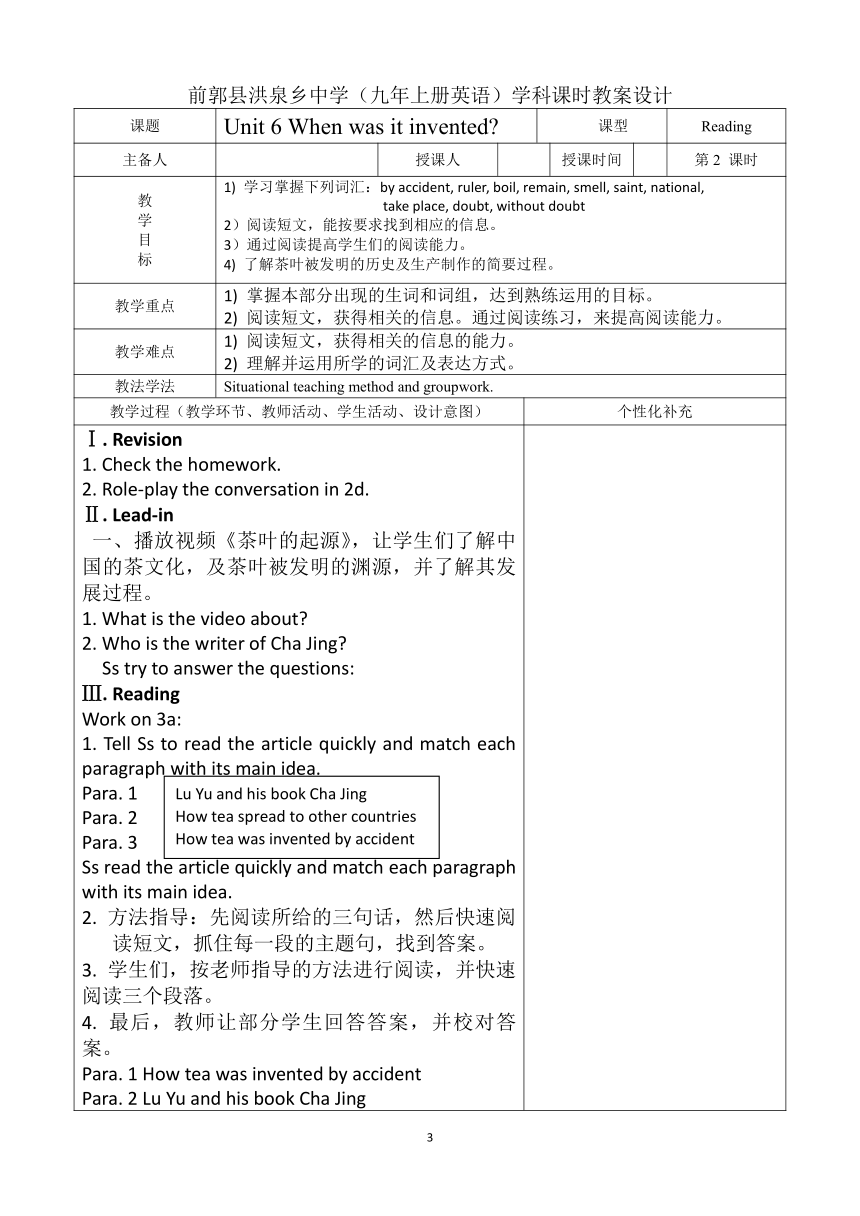Unit 6 When was it invented Section A 教案(3课时,表格式)
文档属性
| 名称 | Unit 6 When was it invented Section A 教案(3课时,表格式) |  | |
| 格式 | docx | ||
| 文件大小 | 32.2KB | ||
| 资源类型 | 教案 | ||
| 版本资源 | 人教新目标(Go for it)版 | ||
| 科目 | 英语 | ||
| 更新时间 | 2023-10-24 19:26:02 | ||
图片预览



文档简介
前郭县洪泉乡中学(九年上册英语)学科课时教案设计
课题 Unit 6 When was it invented 课型 Listening and speaking
主备人 授课人 授课时间 第1 课时
教 学 目 标 1) 能掌握以下单词: heel, scoop, electricity, style, project, pleasure, zipper, daily, website, pioneer, list, mention 能掌握以下句型: ① —When was the telephone invented —I think it was invented in 1876. ② —What are they used for —They are used for seeing at night. 2) 能谈论物品被发明的时间、发明者,表达某发明的用途。
教学重点 1) 本课时的单词、词组和句型,学习运用一般过去时态的被动语态。 2) 学会询问发明时间及用途的基本句型:
教学难点 运用一般过去时态的被动语态来讨论发明的发明时间及用途。
教法学法 Situational teaching method and pair work.
教学过程(教学环节、教师活动、学生活动、设计意图) 个性化补充
I. Warming up 展示一些近代发明的图片与近代发明的发明者,让学生们将图片与发明者相连。 Ⅱ. Presentation 引导学生们学习一般过去时态的被动语态结构。 T: Karl Benz invented the first car in 1885. The first car was invented (by Karl Benz) in 1885. Ⅲ. Talking 1. Look at the pictures in 1a. Discuss with your group, in what order do you think they were invented Try to number them [1-4]. Ⅳ. Listening (1b) 1. T: Tell Ss look at the pictures and years on the left. 2. Play the recording for the Ss to listen. 3. Play the recording again. Ⅴ. Pair work (1c) 1. Ss try to remember the invention and the year. 2. Student B, cover the dates. Student A, ask Student B when the things in the picture in 1b were invented. Then change roles and practice again. Ⅵ. Learning the new words & Listening Work on 2a: 1. Look at the pictures in 2a. Discuss the things what they are used for. 2. Play the recording for the Ss to listen and number the pictures. 3. Play the recording again to check the answers. Work on 2b: 1. Let Ss read the chart below. Explain some main sentences for the Ss. Make sure they know what to do. 2. Play the recording for the Ss to fill in the blanks. 3. Listen again and fill in the blanks. Ⅶ. Pair work (2c) Make a model for the Ss. A: What are the shoes with special heels used for B: They are used for changing the style of the shoes. Ⅷ. Role-play(2d) 1. Read the conversations and Let Ss read after the teacher. 2. Explain some new words and main points in the conversation. 3. Ask Ss to role-play the conversation in groups. Homework 分层作业 布置
板书设计 教学反思
前郭县洪泉乡中学(九年上册英语)学科课时教案设计
课题 Unit 6 When was it invented 课型 Reading
主备人 授课人 授课时间 第2 课时
教 学 目 标 1) 学习掌握下列词汇:by accident, ruler, boil, remain, smell, saint, national, take place, doubt, without doubt 2)阅读短文,能按要求找到相应的信息。 3)通过阅读提高学生们的阅读能力。 4) 了解茶叶被发明的历史及生产制作的简要过程。
教学重点 1) 掌握本部分出现的生词和词组,达到熟练运用的目标。 2) 阅读短文,获得相关的信息。通过阅读练习,来提高阅读能力。
教学难点 1) 阅读短文,获得相关的信息的能力。 2) 理解并运用所学的词汇及表达方式。
教法学法 Situational teaching method and groupwork.
教学过程(教学环节、教师活动、学生活动、设计意图) 个性化补充
Ⅰ. Revision 1. Check the homework. 2. Role-play the conversation in 2d. Ⅱ. Lead-in 一、播放视频《茶叶的起源》,让学生们了解中国的茶文化,及茶叶被发明的渊源,并了解其发展过程。 1. What is the video about 2. Who is the writer of Cha Jing Ss try to answer the questions: Ⅲ. Reading Work on 3a: 1. Tell Ss to read the article quickly and match each paragraph with its main idea. Para. 1 Para. 2 Para. 3 Ss read the article quickly and match each paragraph with its main idea. 2. 方法指导:先阅读所给的三句话,然后快速阅读短文,抓住每一段的主题句,找到答案。 3. 学生们,按老师指导的方法进行阅读,并快速阅读三个段落。 4. 最后,教师让部分学生回答答案,并校对答案。 Para. 1 How tea was invented by accident Para. 2 Lu Yu and his book Cha Jing Para. 3 How tea spread to other countries Work on 3b: 1. 告诉学生们再次阅读短文内容,并回答3b中的所有问题。 2. 学生们先阅读这些问题,理解它们的意思,然后带着相关问题仔细回读短文,并在短文的相关信息处划线。 3. 让学生们回答问题,并校对答案。 Homework 分层作业 布置
板书设计 教学反思
前郭县洪泉乡中学(九年上册英语)学科课时教案设计
课题 Unit 6 When was it invented 课型 Reading
主备人 授课人 授课时间 第3 课时
教 学 目 标 1) 学习掌握下列词汇:fridge, low, somebody, translate, lock, earthquake, sudden, all of a sudden, biscuit, cookie, instrument 2)进行一步复习巩固学习Section A 部分所学的生词和词组。 3)进一步学习运用一般过去时态的被动语态。 4) 掌握主动语态变被动语态的方法,并通过不同方式的练习,来熟练运用。
教学重点 1) 学习生词fridge, low, somebody, translate, lock, earthquake, sudden, all of a sudden, biscuit, cookie, instrument 2) 复习巩固Section A 部分所学的生词和词组,达到熟练运用的目标。
教学难点 1) 一般过去时态的句子变为被动语态。 2) 综合运用所学的知识进行练习运用。.
教法学法 Reading and groupwork
教学过程(教学环节、教师活动、学生活动、设计意图) 个性化补充
Ⅰ. Warming- up and revision 1. Have a dictation of the new words learned in the last class. 2. Review some main phrases we learned in the last class. Check the homework. 3. Let some Ss tell something about how tea was invented by accident. Ⅱ. Grammar Focus. 1. 学生阅读Grammar Focus中的句子,然后做填空练习。 ① 拉链是什么时候被发明的? ______ _____ the zipper ________ ...... 2. 学生们根据记忆,看大屏幕来完成填空练习。 3. 学生们完成填空试题后,可以打开课本检查答案,对错误的句子,单独进行强化记忆。 Ⅲ. Grammar 一般过去时态的被动语态的构成 英语有两种语态:主动语态和被动语态。主动语态表示主语是动作的执行者,而被动语态则表示主语是动作的承受者。 一般过去时被动语态的结构为“主语+ was /were +及物动词的过去分词 (+by+动作的执行者).” 一、被动语态的用法: 1. 不知道谁是动作的执行者,或没有必要指出谁是动作的执行者。 2. 需要突出或强调动作的承受者。 二、主动语态变被动语态应注意的问题 1. 有些短语动词相当于及物动词,变为被动句时介词或副词不能去掉。 2. 含有双宾语的主动句变为被动句时,通常把指“人”的间接宾语变为主语,指“物”的直接宾语保留不变;如果把指物”的直接宾语变为主语,则在间接宾语前加to或for。 3. 主动句中感官动词see/hear/watch/feel等和使役动词make/let/have等后跟省略to 4. 系动词、不及物动词或某些短语动词(happen, take place, come true, fall asleep…)没有被动语态。 Homework 分层作业 布置
板书设计 教学反思
课题 Unit 6 When was it invented 课型 Listening and speaking
主备人 授课人 授课时间 第1 课时
教 学 目 标 1) 能掌握以下单词: heel, scoop, electricity, style, project, pleasure, zipper, daily, website, pioneer, list, mention 能掌握以下句型: ① —When was the telephone invented —I think it was invented in 1876. ② —What are they used for —They are used for seeing at night. 2) 能谈论物品被发明的时间、发明者,表达某发明的用途。
教学重点 1) 本课时的单词、词组和句型,学习运用一般过去时态的被动语态。 2) 学会询问发明时间及用途的基本句型:
教学难点 运用一般过去时态的被动语态来讨论发明的发明时间及用途。
教法学法 Situational teaching method and pair work.
教学过程(教学环节、教师活动、学生活动、设计意图) 个性化补充
I. Warming up 展示一些近代发明的图片与近代发明的发明者,让学生们将图片与发明者相连。 Ⅱ. Presentation 引导学生们学习一般过去时态的被动语态结构。 T: Karl Benz invented the first car in 1885. The first car was invented (by Karl Benz) in 1885. Ⅲ. Talking 1. Look at the pictures in 1a. Discuss with your group, in what order do you think they were invented Try to number them [1-4]. Ⅳ. Listening (1b) 1. T: Tell Ss look at the pictures and years on the left. 2. Play the recording for the Ss to listen. 3. Play the recording again. Ⅴ. Pair work (1c) 1. Ss try to remember the invention and the year. 2. Student B, cover the dates. Student A, ask Student B when the things in the picture in 1b were invented. Then change roles and practice again. Ⅵ. Learning the new words & Listening Work on 2a: 1. Look at the pictures in 2a. Discuss the things what they are used for. 2. Play the recording for the Ss to listen and number the pictures. 3. Play the recording again to check the answers. Work on 2b: 1. Let Ss read the chart below. Explain some main sentences for the Ss. Make sure they know what to do. 2. Play the recording for the Ss to fill in the blanks. 3. Listen again and fill in the blanks. Ⅶ. Pair work (2c) Make a model for the Ss. A: What are the shoes with special heels used for B: They are used for changing the style of the shoes. Ⅷ. Role-play(2d) 1. Read the conversations and Let Ss read after the teacher. 2. Explain some new words and main points in the conversation. 3. Ask Ss to role-play the conversation in groups. Homework 分层作业 布置
板书设计 教学反思
前郭县洪泉乡中学(九年上册英语)学科课时教案设计
课题 Unit 6 When was it invented 课型 Reading
主备人 授课人 授课时间 第2 课时
教 学 目 标 1) 学习掌握下列词汇:by accident, ruler, boil, remain, smell, saint, national, take place, doubt, without doubt 2)阅读短文,能按要求找到相应的信息。 3)通过阅读提高学生们的阅读能力。 4) 了解茶叶被发明的历史及生产制作的简要过程。
教学重点 1) 掌握本部分出现的生词和词组,达到熟练运用的目标。 2) 阅读短文,获得相关的信息。通过阅读练习,来提高阅读能力。
教学难点 1) 阅读短文,获得相关的信息的能力。 2) 理解并运用所学的词汇及表达方式。
教法学法 Situational teaching method and groupwork.
教学过程(教学环节、教师活动、学生活动、设计意图) 个性化补充
Ⅰ. Revision 1. Check the homework. 2. Role-play the conversation in 2d. Ⅱ. Lead-in 一、播放视频《茶叶的起源》,让学生们了解中国的茶文化,及茶叶被发明的渊源,并了解其发展过程。 1. What is the video about 2. Who is the writer of Cha Jing Ss try to answer the questions: Ⅲ. Reading Work on 3a: 1. Tell Ss to read the article quickly and match each paragraph with its main idea. Para. 1 Para. 2 Para. 3 Ss read the article quickly and match each paragraph with its main idea. 2. 方法指导:先阅读所给的三句话,然后快速阅读短文,抓住每一段的主题句,找到答案。 3. 学生们,按老师指导的方法进行阅读,并快速阅读三个段落。 4. 最后,教师让部分学生回答答案,并校对答案。 Para. 1 How tea was invented by accident Para. 2 Lu Yu and his book Cha Jing Para. 3 How tea spread to other countries Work on 3b: 1. 告诉学生们再次阅读短文内容,并回答3b中的所有问题。 2. 学生们先阅读这些问题,理解它们的意思,然后带着相关问题仔细回读短文,并在短文的相关信息处划线。 3. 让学生们回答问题,并校对答案。 Homework 分层作业 布置
板书设计 教学反思
前郭县洪泉乡中学(九年上册英语)学科课时教案设计
课题 Unit 6 When was it invented 课型 Reading
主备人 授课人 授课时间 第3 课时
教 学 目 标 1) 学习掌握下列词汇:fridge, low, somebody, translate, lock, earthquake, sudden, all of a sudden, biscuit, cookie, instrument 2)进行一步复习巩固学习Section A 部分所学的生词和词组。 3)进一步学习运用一般过去时态的被动语态。 4) 掌握主动语态变被动语态的方法,并通过不同方式的练习,来熟练运用。
教学重点 1) 学习生词fridge, low, somebody, translate, lock, earthquake, sudden, all of a sudden, biscuit, cookie, instrument 2) 复习巩固Section A 部分所学的生词和词组,达到熟练运用的目标。
教学难点 1) 一般过去时态的句子变为被动语态。 2) 综合运用所学的知识进行练习运用。.
教法学法 Reading and groupwork
教学过程(教学环节、教师活动、学生活动、设计意图) 个性化补充
Ⅰ. Warming- up and revision 1. Have a dictation of the new words learned in the last class. 2. Review some main phrases we learned in the last class. Check the homework. 3. Let some Ss tell something about how tea was invented by accident. Ⅱ. Grammar Focus. 1. 学生阅读Grammar Focus中的句子,然后做填空练习。 ① 拉链是什么时候被发明的? ______ _____ the zipper ________ ...... 2. 学生们根据记忆,看大屏幕来完成填空练习。 3. 学生们完成填空试题后,可以打开课本检查答案,对错误的句子,单独进行强化记忆。 Ⅲ. Grammar 一般过去时态的被动语态的构成 英语有两种语态:主动语态和被动语态。主动语态表示主语是动作的执行者,而被动语态则表示主语是动作的承受者。 一般过去时被动语态的结构为“主语+ was /were +及物动词的过去分词 (+by+动作的执行者).” 一、被动语态的用法: 1. 不知道谁是动作的执行者,或没有必要指出谁是动作的执行者。 2. 需要突出或强调动作的承受者。 二、主动语态变被动语态应注意的问题 1. 有些短语动词相当于及物动词,变为被动句时介词或副词不能去掉。 2. 含有双宾语的主动句变为被动句时,通常把指“人”的间接宾语变为主语,指“物”的直接宾语保留不变;如果把指物”的直接宾语变为主语,则在间接宾语前加to或for。 3. 主动句中感官动词see/hear/watch/feel等和使役动词make/let/have等后跟省略to 4. 系动词、不及物动词或某些短语动词(happen, take place, come true, fall asleep…)没有被动语态。 Homework 分层作业 布置
板书设计 教学反思
同课章节目录
- Unit 1 How can we become good learners.
- Section A
- Section B
- Unit 2 I think that mooncakes are delicious!
- Section A
- Section B
- Unit 3 Could you please tell me where the restroom
- Section A
- Section B
- Unit 4 I used to be afraid of the dark.
- Section A
- Section B
- Unit 5 What are the shirts made of?
- Section A
- Section B
- Review of Units 1-5
- Unit 6 When was it invented?
- Section A
- Section B
- Unit 7 Teenagers should be allowed to choose their
- Section A
- Section B
- Unit 8 It must belong to Carla.
- Section A
- Section B
- Unit 9 I like music that I can dance to.
- Section A
- Section B
- Unit 10 You're supposed to shake hands.
- Section A
- Section B
- Review of Units 6-10
- Unit 11 Sad movies make me cry.
- Section A
- Section B
- Unit 12 Life is full of the unexpected
- Section A
- Section B
- Unit 13 We're trying to save the earth!
- Section A
- Section B
- Unit 14 I remember meeting all of you in Grade 7.
- Section A
- Section B
- Review of Units 11-14
